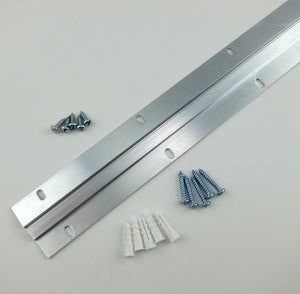About Light Cleat 18 inch Wood Frame Kit
- 18" Long Light-Duty Cleat Hanger Set for Wood Frame
- For wood frames 21-30 inches wide
- 18 inch cleat supports 150 pounds. Cleat rated to support 100 pounds per linear foot
- made of extruded aluminum 1 1/8" tall by 3/64" thick
- wall standoff is 1/4 inch
- All necessary fastening hardware required for installation is included
Wood Cleat Kit includes
- (2) 1 1/8" x 18" cleats - one for the wall and one for frame
- (5) #8 x 1/2" screws - to attach one cleat to art
- (5) #8 x 1" screws - to attach one cleat to wall
- (5) #8 plastic anchors - if needed to attach cleat to wall
Description
Light-Duty Cleat Hangers are normally attached to the wall with the screws and plastic anchors supplied. This fastening method creates a solid, stable support for the frame. You can substitute different fastener hardware if you prefer.
The 18" cleats have five pre-punched holes four inches on center. Only very minimal leveling adjustments are possible after installation so it is imperative to mount cleats as level as possible the first time.
If you are using a Light-Duty Cleat Hanger on a narrow wood frame with a long horizontal span, make certain that the frame is sufficiently braced internally so that the frame's top rail will remain rigid under load. The cleat is 1 1/8 inches wide so the wood frame must be at least that width to accommodate the cleat.
We have a number of customers who have used Light-Duty Cleats to hang something with a backing material that is either too thin or too soft to accept screw fasteners. In these cases usually either a silicone-based liquid adhesive or a good quality double-sided foam-backed tape has been used to attach the cleat instead of screws. In these situations be aware that the adhesive you use must adhere equally well to the aluminum cleat and whatever backing material you are dealing with and create a permanent bond on both surfaces.
Instructions
- Measure and mark for the position of the wall cleat on the wall. The wall cleat should be oriented so that the screw holes are on the bottom and the top edge is open and out from the wall. This cleat must be installed as level as possible .
- This cleat must be installed as level as possible.
- Attach the cleat to the wall at your marks using the #8 x 1" screws and plastic wall anchors provided. Small adjustments to level can be made by making use of the slotted screw holes.
- Place the wood frame or panel face down on a blanket or soft surface and attach the second cleat provided to the back of the frame's top rail, slightly down from the top edge and centered on the rail, using the #8 x 1/2" screws provided. The cleat should be mounted so that the screw holes are on the top and the bottom edge is open and out from the frame rail. This cleat must be installed as level as possible (positioned down evenly from the top edge of the frame) .
- To hang the frame, place it flush against the wall so that the bottom edge of the frame cleat is positioned slightly above the top edge of the wall cleat and the frame is centered on the wall cleat. Let the frame slide down the wall slowly and evenly until the cleats connect together completely Some side-to-side adjustment can be made by lifting the frame slightly and shifting it to the left or right. When adjusting a wood frame in this way make sure that the frame cleat and the wall cleat are engaged along at least 90% of their length.
- To remove the frame from the wall completely, lift the frame directly upward a couple of inches to disengage the cleats.


